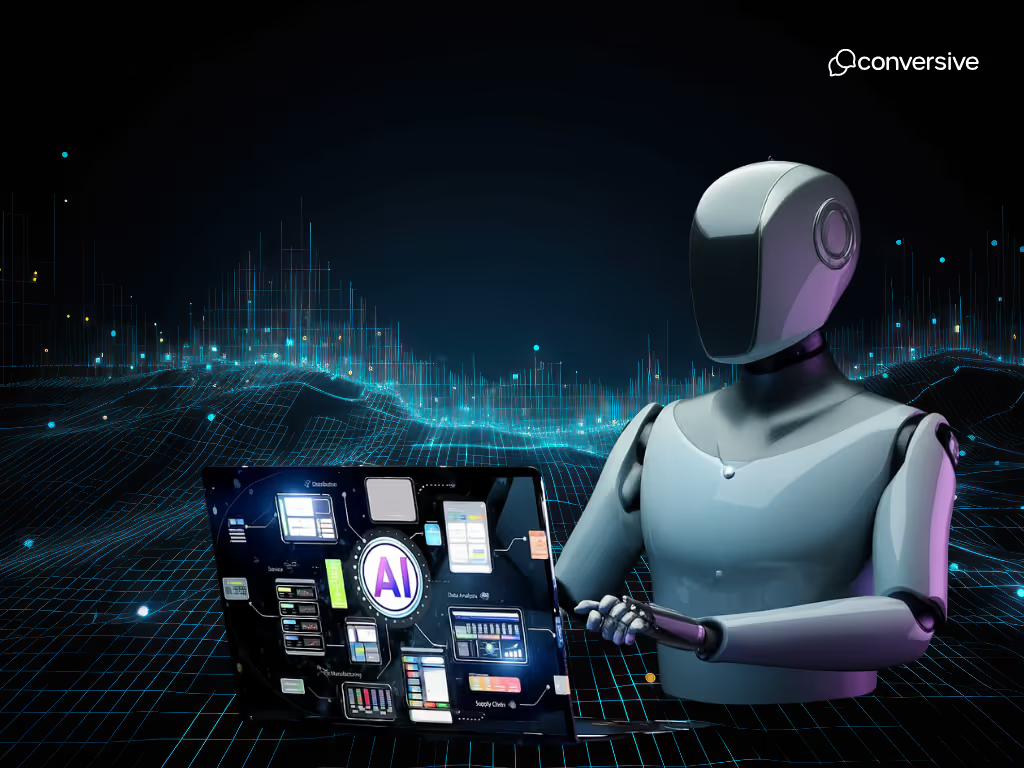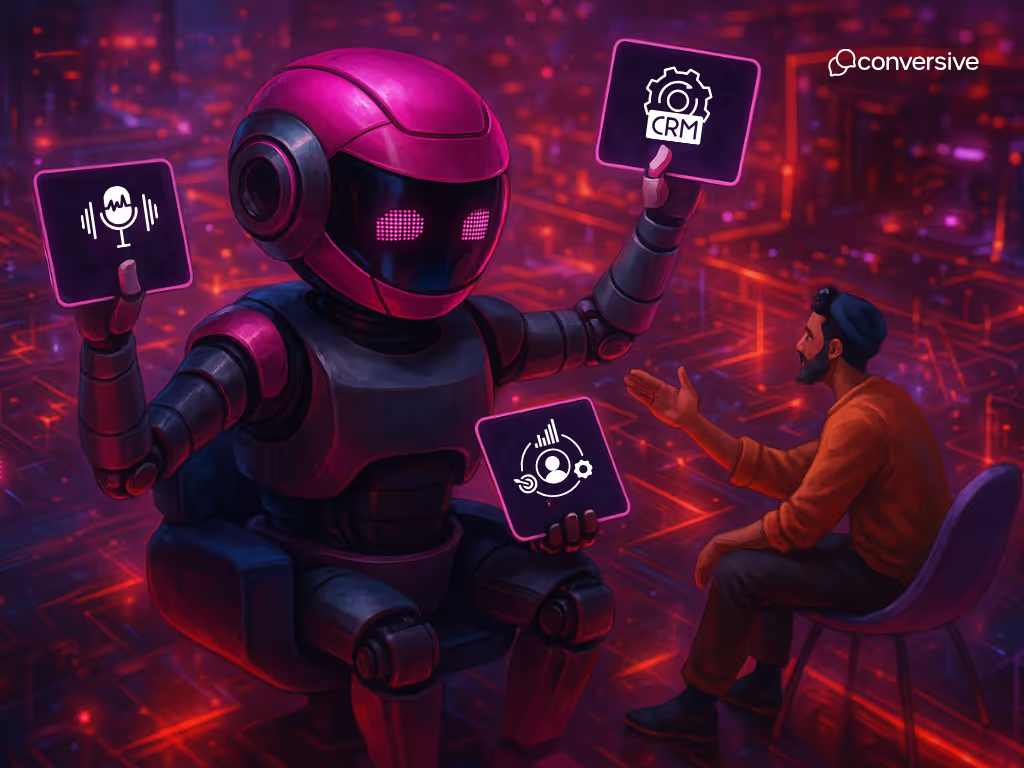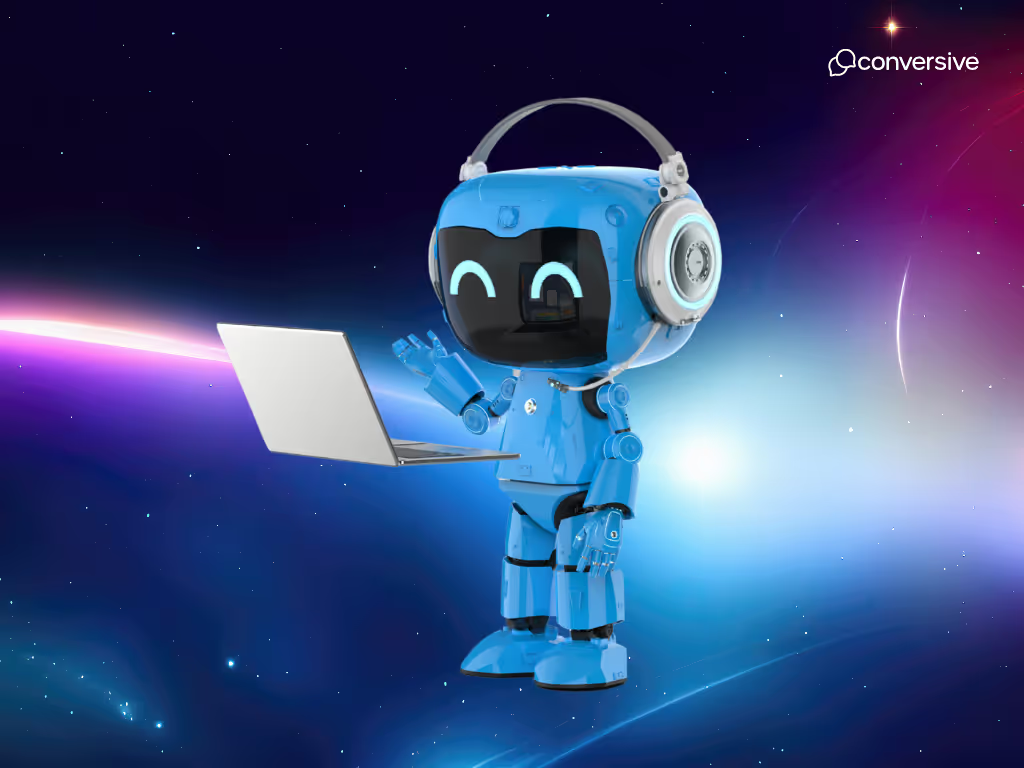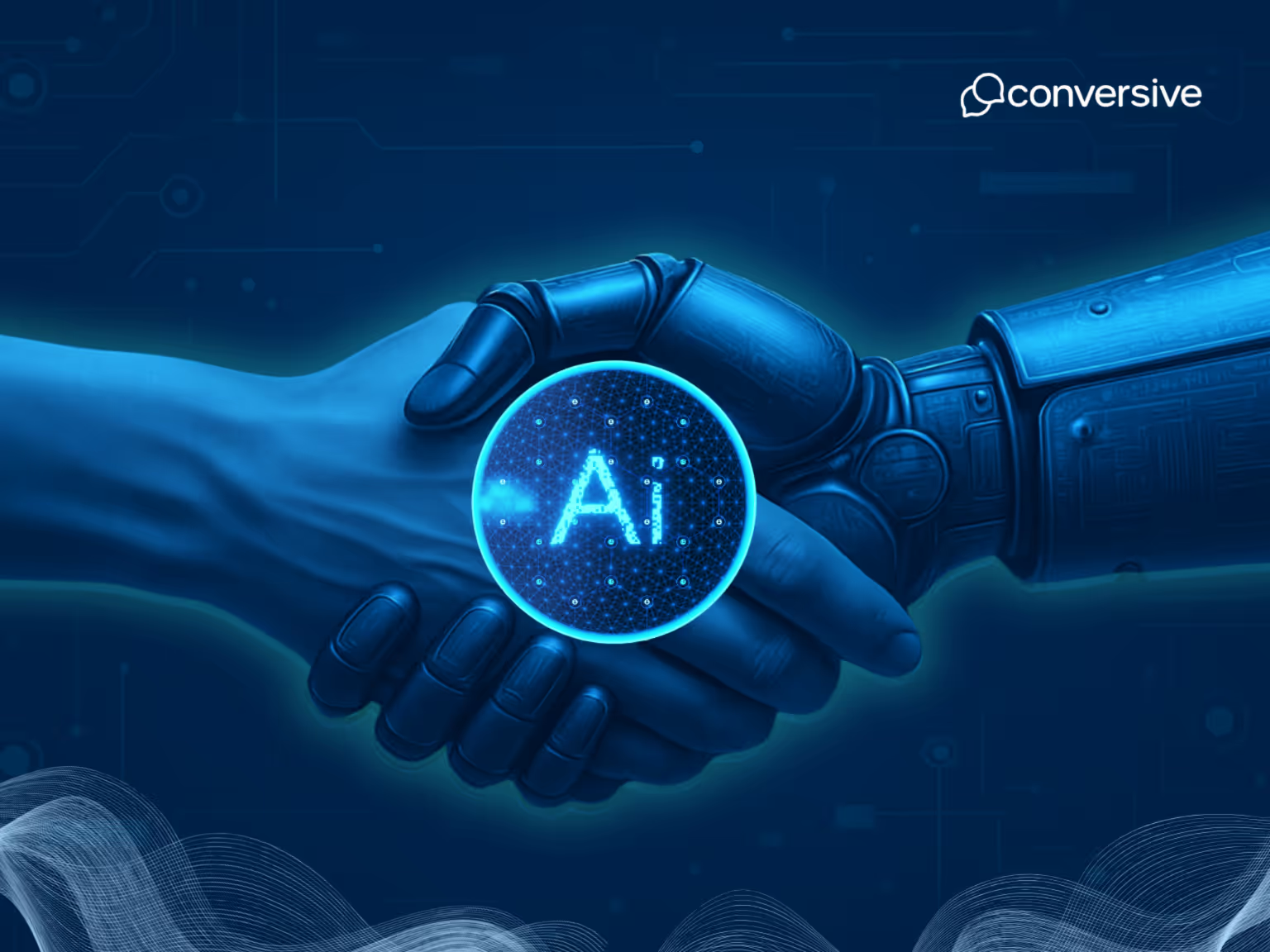
How Is AI in CRM Revolutionizing Customer Experience, And Are You Keeping Up?
AI in CRM replaces poor customer experiences with faster, smarter, and more personalized service. It helps businesses predict needs, automate interactions, and boost satisfaction, turning CRM into a proactive growth engine.
“AI isn’t replacing humans, it’s replacing bad customer experiences”.
Customers now expect better, faster, reliable and more personalized interactions. Using AI in customer relationship management (CRM) helps businesses automatically anticipate what customers need, respond more quickly, and tailor their services to each individual.
This is a big shift from reactive support to proactive and smarter interactions. The message is clear, AI is a tool to improve how companies connect with customers, and if you learn to use it now, you can stay ahead of the competition.
For example, a customer logs into an online clothing store and receives a notification suggesting weather-appropriate outfit recommendations based on their location and past browsing history, along with a quick chat option for any questions.
Customer expectations have fundamentally shifted, and AI in CRM has emerged as the game-changing response. We’re now living in the era of proactive, predictive, and hyper-personalized engagement. And in this guide, I’m going to show you how it works, why it matters, and what you can do right now to stay ahead.
So, let’s take this head-on!
Why AI-Powered CRM Is No Longer Optional?
AI and Customer Experience are now working together, changing how companies interact with customers. Before, systems called CRM (Customer Relationship Management) helped sales and support teams keep track of customer info and interactions. Now, with AI in the mix, these systems can guess what customers might need, suggest what actions to take, and handle many customer interactions automatically, making the whole process faster and more personalized.
Here’s how: A small online clothing store uses an AI-enhanced CRM that notices a customer repeatedly browsing winter jackets but not purchasing. The system then automatically sends a personalized email offering a discount on winter coats, increasing the chance of a sale without the staff needing to intervene.
According to Forbes, when companies use AI, they beat the competition, with average revenue increases up to 15%. McKinsey & Company uses AI-powered intelligence to deliver customer-centric experiences, which results in 10-20% revenue growth.
In short: if your CRM isn't AI-powered, you're already behind.
How AI Is Transforming CRM Systems
Old CRM was reactive, new CRM is proactive - simple and to the point!
A traditional CRM is like a digital filing system where you store information about customers, which is organized and easy to access but doesn’t do much on its own. On the other hand, an AI-powered CRM is more like a smart helper that not only stores data but also suggests useful insights, creates messages or content, and helps you decide what to do next, all in real time.
Let’s say, a sales representative logs a call with a potential customer in the AI-enhanced CRM. The system instantly analyzes the conversation, notes that the customer is interested in a specific product feature, and recommends the best follow-up email to send. It also suggests the optimal time to reach out again and provides personalized talking points based on previous interactions, thus, helping the representative to engage the customer more effectively.
What powers this shift?
- Machine Learning (ML): It’s a way AI or the model get better at things by looking at interactions from the past, so they can guess what might happen next.
- Natural Language Processing (NLP): It analyses how people feel when they talk or write, and also allows them to have conversations that seem real.
- Predictive Analytics: This is about using data to spot customers who might leave soon or find the best people to sell to.
- Generative AI: It can create things like emails, ideas for content, or replies in conversations on the spot, making work faster.
Here’s how it works: A customer service chatbot that detects when a customer is frustrated based on their message sentiment, then suggests helpful solutions or escalates the issue to a human agent.
According to IBM, businesses using AI produce 30% more output with the same resources. Its watsonx Assistant, used by Camping World, boosted customer engagement by 40% and improved agent productivity by 33% by handling routine inquiries and gathering initial information.
10 Key Benefits of Using AI in CRM
Adding AI to CRM systems isn't just about upgrading software, rather, it's a big change in how a business operates. It helps keep customers happier and more loyal, makes daily work smoother and faster, and allows companies to make quick decisions based on what's happening right now with their customers. The list that follows highlights the ten most important benefits for businesses, with how it works, examples, and key insights of why they matter strategically.
1. Hyper-Personalization at Scale
AI helps brands create more personalized interactions with people, making messages and experiences that change based on what someone does, their situation, and what they want. Instead of just using generic greetings, AI makes it possible to tailor what’s offered or said to each person individually.
How it works: AI models analyze browsing history, past purchases, support history, and even preferred channels to tailor offers, messages, and experiences.
Example: A coffee shop app notices that a customer frequently orders caramel lattes in the afternoon. One day, the app sends a personalized message: "Good afternoon! Your favorite caramel latte is on special today.
Key Insight: Customers now expect personalized experiences. In fact, 76% of consumers get frustrated when personalization is lacking.
2. Predictive Customer Behavior Modeling
The AI can figure out not only what your customer is interested in buying, but also the best time to reach them and the reasons behind their choices.
How it works: ML models use historical and real-time data to identify patterns, such as when a customer is likely to purchase, upgrade, or churn.
Example: A clothing store's AI notices that a customer frequently searches for rain jackets in September and October. Based on this, it suggests rain jackets to the customer in late August, ahead of the rainy season, and even explains that many customers buy rain jackets around this time because the weather is about to turn wet.
Key Insight: Proactive outreach increases conversion and reduces customer attrition, especially when timed perfectly.
3. Real-Time Support and Intelligent Chatbots
AI-powered chatbots can reply to questions, remember things to improve over time, and pass on more complicated issues to a human, all very quickly.
How it works: NLP allows bots to understand intent, provide contextual answers, and improve with every interaction.
Example: A traveler uses an airline’s mobile app to check flight options. The AI assistant helps narrow down flights based on preferred departure times and previous travel history. When the traveler asks about carry-on luggage policies, the assistant provides a clear summary. Upon requesting special assistance for mobility needs, the assistant promptly hands off the conversation to a human agent to ensure personalized support.
Key Insight: This reduces support costs by up to 30%, while maintaining customer satisfaction through 24/7 instant assistance.
4. Automated Lead Scoring and Intelligent Segmentation
Don't treat all potential customers the same. Use AI to decide which ones are more likely to make a purchase, so you can focus on those first.
How it works: AI models assign scores based on engagement, fit, buying signals, and historical data. Segmentation can then auto-adjust based on behavior changes.
Example: Imagine a salesperson working at a car dealership. Instead of calling every interested customer equally, the salesperson uses an AI system that scores each customer based on how likely they are to buy a car soon. Customers who have shown strong interest or are ready to buy get a priority call, while less interested ones are contacted later.
Key Insight: Approximately 25 - 27% of leads are deemed sales-ready, AI helps sales teams focus on those that truly matter.
5. Proactive Churn Prevention
AI systems can spot warning signs or problems early on, before your customers notice them.
How it works: Models analyze complaints, drop-offs in engagement, and usage anomalies to alert CX teams of potential churn and spam risk.
Example: A customer calls to order a product, and the AI notices unusual language indicating a potential scam. It flags the order for review, preventing a fraudulent transaction before the customer even realizes there’s a problem.
Key Insight: According to Forbes, acquiring a new customer can cost 5 to 7 times more than retaining an old one.
6. Sentiment Analysis and Emotion Tracking
Your CRM can now read between the lines, like reading hints or understanding the underlying meaning.
How it works: NLP models detect tone, frustration, happiness, or sarcasm in customer emails, chats, and reviews.
Example: Let’s say you manage a hotel chain and want to stay on top of guest feedback. Instead of reading every review manually, your AI-powered CRM scans and analyzes them, automatically surfacing recurring issues, like housekeeping delays on weekends or frequent noise complaints from certain floors. This helps you take quicker, more focused action to improve the guest experience.
Key Insight: Emotional intelligence, when automated at scale, leads to more empathetic and timely interventions.
7. Intelligent Workflow Automation
AI can take care of boring, repetitive jobs by doing them accurately and without getting tired. It can do these tasks quickly and handle many of them at the same time.
How it works: AI triggers follow-ups, assigns tickets, updates CRM fields, or routes leads based on pre-trained workflows.
Example: Salesforce Flow, enhanced by Einstein AI, automates millions of processes like post-meeting follow-ups or missed payment nudges.
Key Insight: Teams spend 60% of their time on admin tasks, AI frees them to focus on strategy and human touch.
8. Voice and Speech Recognition in Service
Speaking and listening are now the main way we interact with technology, like talking to a voice assistant. AI acts as the translator, understanding what we're saying and figuring out how to respond or do what we ask.
How it works: AI listens to calls, transcribes them, detects sentiment, and tags topics, all in real time.
Example: You’re driving and say, “Find the nearest coffee shop”. Your voice command is sent to an AI that interprets what you said and then shows you a map with nearby coffee shops on your car's display.
Key Insight: No more manual notes. Voice AI gives CRM real-time context to improve service quality and compliance.
9. Adaptive Learning for Sales Reps and Service Agents
AI is starting to act like a personal coach or guide, helping you improve or learn things, rather than just being a simple tool you use to do tasks.
How it works: AI copilots analyze patterns from high-performing reps, suggesting scripts, rebuttals, and knowledge during live calls.
Example: A fitness app that not only tracks your workouts but also encourages you, suggests personalized exercises based on your progress, and offers motivational messages to keep you motivated.
Key Insight: AI is evolving into a real-time personal coach for sales and service reps, analyzing top performers and providing tailored guidance like scripts and rebuttals to boost effectiveness during live interactions.
10. Seamless Omnichannel Experience Integration
AI brings together all the ways a customer interacts with a company, like visiting the website, talking to customer service, or buying products, so that it feels seamless and connected, creating a smooth overall experience.
How it works: CRM connects to chat, email, web, app, social, and in-store systems. AI tracks context across channels, ensuring continuity.
Example: Disney’s MagicBand system is powered by AI and CRM data to create fluid cross-platform experiences, from hotel to park to app.
Key Insight: According to Harvard Business Review, 73% of customers use multiple channels before making a purchase. AI ensures it feels like one brand, one journey.
Takeaway
Using AI in CRM isn't about adding more work or features. It's about focusing on the most important tasks and completing them more quickly and wisely. The ten advantages mentioned above aren't just about making tasks automatic, they are about helping organizations increase revenue, improve retention, and deliver superior experiences at scale.

How Understanding the AI Ecosystem Transforms Your CRM into a Growth Engine
AI in CRM isn’t just about adding a chatbot or using a smart prediction tool. It’s a complicated system that includes many parts working together, like smart data systems, advanced AI technologies, ways to connect different tools, various software platforms, and rules to ensure everything runs properly.
Knowing how all these pieces fit together is important if you want to get the most benefit from AI in improving how you connect and serve customers. Let’s break down the key components that power this transformation:
1. Intelligent Data Foundations
At the core of every AI-powered CRM lies information about customers that needs to be accurate, organized, accessible and up-to-date.
A Customer Data Platform (CDP) is a tool that gathers all this customer information from different sources like websites, mobile apps, social media, and even offline stores. Instead of data being kept separately, it’s combined into one complete profile for each customer. This helps companies see everything about a customer in one place and makes it easier for AI to analyze and use the data.
Since third-party cookies (small data files used to track online activity across different websites) are being phased out, companies now rely more on data they collect directly from their customers, like when someone agrees to share their information. This first-party data is safer and more trustworthy, and AI uses it to offer personalized experiences without invading privacy.
Finally, the system constantly updates with new data in real-time. This ongoing flow of fresh information allows AI to make quick decisions, such as customizing offers instantly or scoring leads based on the latest activity. If this data didn’t update continuously, AI insights would become outdated and less useful.
2. AI & Machine Learning Models in CRM
AI makes CRM really smart. Various types of AI models work behind the scenes:
- Predictive Models: Some AI predicts what customers might do next, like whether they’ll stop using a service, how much they’re likely to spend over time, or what products they’re interested in. This helps companies prepare and act before issues happen or sales are lost.
- Recommender Systems: Other AI models suggest products or content similar to what a customer already likes, like how Netflix recommends shows. This helps businesses sell more by offering things the customer might want.
- NLP Engines: Natural Language Processing (NLP) is a type of AI that reads and understands customer messages, emails, or calls. It figures out how the customer feels, what they want, or their reason for reaching out. This helps companies route messages better and respond more quickly and appropriately, sometimes automatically.
- Generative AI: can create new content on its own, such as personalized emails, follow-up messages, or product descriptions that sound natural and human.
All these AI tools turn a basic customer database into a smart system that helps companies make better decisions, serve customers better, and sell more effectively.
3. CRM + AI Integration Stack
To connect AI tools with CRMs, you need a setup that allows these systems to talk to each other smoothly.
- APIs & Middleware: This setup uses tools called APIs and middleware, which act like bridges, sending data back and forth, starting AI processes, and getting quick responses.
- No-Code Platforms: There are also platforms like Zapier and Workato that let people create these connections without needing to write complicated code. This makes it faster and easier for teams to start using AI in their work.
- Low-Code Tools: Additionally, new simple tools are coming out that let teams like marketing or sales try out AI features and automation without IT help, making it easier to experiment and improve quickly.
All these pieces work together so AI becomes part of regular customer management tasks, not something separate or complicated.
4. Platform Ecosystem
The AI-driven CRM landscape is broad and evolving. Instead of thinking about individual tools, it's better to look at different types or categories. Big companies like Salesforce, Microsoft, and HubSpot offer all-in-one, advanced AI features built into their entire platforms, which can grow with your business.
There are also other companies that focus on specific innovations. For example, Drift mainly works on AI that helps chat with customers automatically, while ZapScale uses AI to help grow a business’s product and sales more efficiently.
Some CRM tools are designed for particular industries, like Veeva for healthcare, Clari for predicting sales, and Zendesk AI for improving customer support.
Choosing the right tools depends on what your business needs, what industry you're in, and how advanced your current systems are.
5. Governance, Ethics & Trust
Embedding AI into CRM systems comes with important responsibilities:
- Explainability: The AI should be able to clearly tell why it made a particular decision or recommendation. This helps both the business and the customer understand and trust the system.
- Bias Prevention: The AI must avoid making unfair or biased decisions. Regular checks, diverse data to train the AI, and special algorithms help prevent discrimination or unfair treatment.
- Compliance-Ready Systems: The AI must follow privacy laws like GDPR in Europe and CPRA in California. This involves getting proper consent from customers and only collecting necessary data.
By focusing on ethics and proper governance, companies not only follow the law but also build trust with their customers, something really valuable for long-term success.
Real-World Applications of AI in CRM
From retail to banking, hospitality to telecom, AI-powered tools are helping companies better understand and engage their customers, resulting in significant improvements in loyalty, sales, and efficiency.
Sephora (Retail)
Sephora uses chatbots and AI to recommend products based on skin tone, preferences, and even mood. Their Color IQ tool uses AI-powered imaging to match foundation shades.
Result:
- Improved brand loyalty
- E-commerce sales grew from $580M (2016) to $3B (2022)
- 4x increase in online sales in 6 years
Bank of America’s Erica (Banking)
Bank of America’s, Erica, an AI-powered virtual financial assistant helps clients with everyday banking - handling over 2 million interactions daily. Erica offers insights on spending, tracks subscriptions, retrieves account info, and even shares jokes or birthday wishes, creating a more personal digital experience. Integrated across platforms like Merrill and CashPro, Erica combines speed, intelligence, and human-like support.
Result:
- 2B+ interactions since 2018
- 98% of users get answers in under 44 seconds
- 50,000+ performance updates to improve accuracy and relevance
Hilton (Hospitality)
Hilton Worldwide leverages AI across its hospitality operations to deliver personalized guest experiences, streamline customer service, and optimize business efficiency. Using ML & data analytics, Hilton tailors recommendations, enhances marketing, and powers AI-driven chatbots that provide instant 24/7 assistance.
Result:
- 30% increase in personalized booking conversions
- 24/7 AI chatbots handle over 1 million guest interactions monthly
- Dynamic pricing boosts revenue by up to 12% during peak demand
Salesforce Einstein (B2B SaaS)
Uses predictive scoring to help sales reps focus on leads that are most likely to close. T-Mobile used Salesforce Einstein to automatically prioritize incoming leads.
Result:
- Increased the conversion rate of these leads by 30%.
- Improved sales productivity by 15%.
- Increased customer satisfaction by 25% by better channeling queries.
Telecom
XAI-Churn TriBoost is an interpretable AI model combining XGBoost, CatBoost, and LightGBM for improved predictions. It processes over 2 million customer records.
Data is meticulously cleaned: missing values are filled iteratively, data is standardized, key features are selected, and class imbalance is corrected. This ensures the model is both reliable and easy to interpret when predicting customer churn.
Result:
- 96.44% accuracy in churn prediction
- 20% reduction in customer churn (industry benchmark)
- Key churn drivers identified for targeted retention (e.g., regularity, montant)
- Explainable AI builds trust and actionable insights for telecom providers
Strategic Considerations for AI Implementation in CRM
Implementing AI in CRM isn't just about technology, rather it's about aligning strategy, people, and data. Here are five key considerations to ensure AI delivers real, responsible value.
1. Data Maturity
If your data is messy or disorganized, your AI will give you unreliable results. Before trying to use AI to learn from your data, you should clean it up, combine different data sources properly, and make sure everything is consistent and accurate. Good, clean data is what makes AI work well.
2. Align with CX KPIs
AI should focus on helping customers and making their experience better, rather than just collecting data that looks good but doesn’t matter. When building AI systems, aim to improve specific, tangible results that show how satisfied customers are (like NPS and CSAT) or how much value a customer brings over time (CLV). Every AI project should have a clear purpose and actually contribute to the business’s success.
3. Cross-Functional Buy-In
Companies are using AI in their CRM across many parts of the business, like sales, marketing, IT, customer support, and legal. It's important to involve the people from these groups early on, agree on common goals, and make sure everyone understands how they share data, how they work together, and how their efforts affect customers.
4. Team Reskilling
Your team needs more than just the right equipment; they also need to understand how it works. Provide training on basic ideas about artificial intelligence, such as different types of AI models, ethical considerations, and how to use AI properly. Teach them how to ask the right questions or give the right instructions (prompt engineering) so people without technical backgrounds can use AI effectively.
5. Governance First
Before using new technology or AI systems, set up rules and checks to keep things on track. This includes having people review decisions, knowing who to contact if something goes wrong, and regularly checking that everything follows the rules. Making AI responsible and safe isn’t just a nice idea; it’s necessary.

Don’t Just Manage Relationships, Reimagine Them with Conversive
You’ve seen how AI is redefining CRM, from static systems of record to intelligent engines of growth. Now it’s time to act.
Conversive isn’t just about messaging, it’s about delivering meaningful conversations at scale that feel human, timely, and deeply relevant. Native to your CRM, Conversive unifies data, automation, and AI into one seamless flow, turning customer signals into conversations, and conversations into conversions.
- Be First. Be Relevant. Engage customers the moment it matters most, based on real-time triggers, behaviors, and intent.
- Stay Compliant. Stay Confident. Built-in TCPA, GDPR, HIPAA, and 10DLC compliance means your outreach is always secure and permission-based.
- Automate with Empathy. AI-guided workflows and sentiment-aware chatbots help you scale conversations without losing the human touch.
- Unify Your Channels. SMS, WhatsApp, RCS, email, social DMs, every thread mapped to your CRM for total visibility and continuity.
- Built for Your Industry. Whether you’re in higher ed, healthcare, finance, or legal, Conversive adapts to your workflows, not the other way around.
This is your competitive edge, predictive, proactive, and personal. Ready to move beyond campaigns and start real conversations? Book a personalized demo today!
Frequently Asked Questions
1. What is AI-powered CRM?
AI-powered CRM integrates artificial intelligence into customer relationship management systems to automate tasks, analyze customer behavior, and deliver personalized experiences at scale.
2. How is AI different from traditional CRM tools?
Traditional CRM stores and organizes customer data, while AI enhances it by making predictions, automating communication, and providing real-time insights to drive smarter decisions.
3. Is AI in CRM only for large businesses?
Not at all. Many AI tools are now accessible to small and medium-sized businesses through platforms that offer low-code or no-code solutions, allowing anyone to get started quickly.
4. What kind of data do I need to use AI in my CRM?
You’ll need accurate, clean, and up-to-date customer data, like purchase history, website interactions, support tickets, and communication preferences, for AI to provide reliable insights.
5. How does AI improve customer support?
AI enables 24/7 support via chatbots, automates routine responses, detects customer sentiment, and escalates complex cases to human agents faster, improving speed and satisfaction.
6. Can AI help prevent customer churn?
Yes. AI can identify early warning signs such as drop-offs in engagement, negative sentiment, or repeated issues, and recommend proactive steps to retain at-risk customers.
7. What industries can benefit from AI in CRM?
Virtually all industries, including retail, banking, healthcare, education, telecom, and hospitality, can benefit from AI-enhanced CRM to improve customer engagement and operations.
8. Is AI in CRM safe and compliant with data privacy laws?
Yes, if implemented correctly. Modern AI-powered CRMs include tools to help maintain compliance with regulations like GDPR, HIPAA, and TCPA, and ensure responsible data usage.
9. How can I get started with AI in my CRM?
Start by assessing your data quality, identifying customer experience goals, choosing the right platform or tools (like Conversive), and ensuring your team is trained and ready.



.png)

